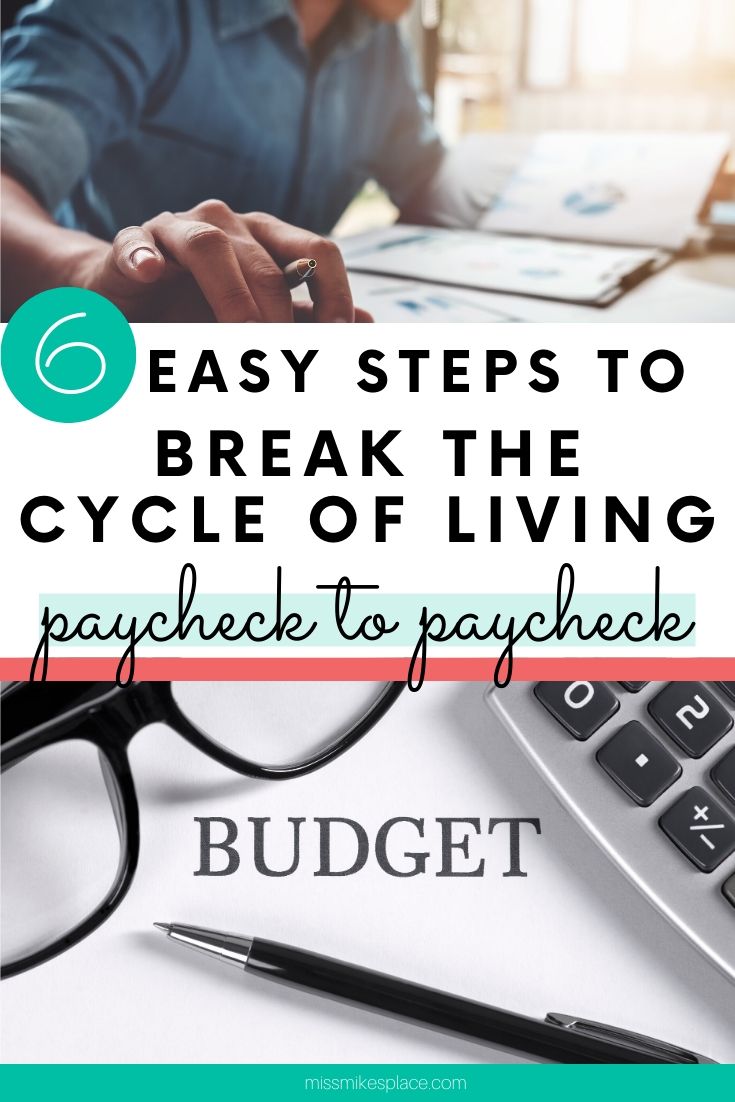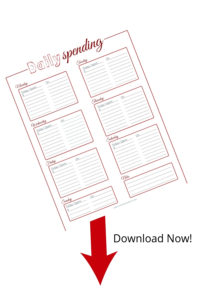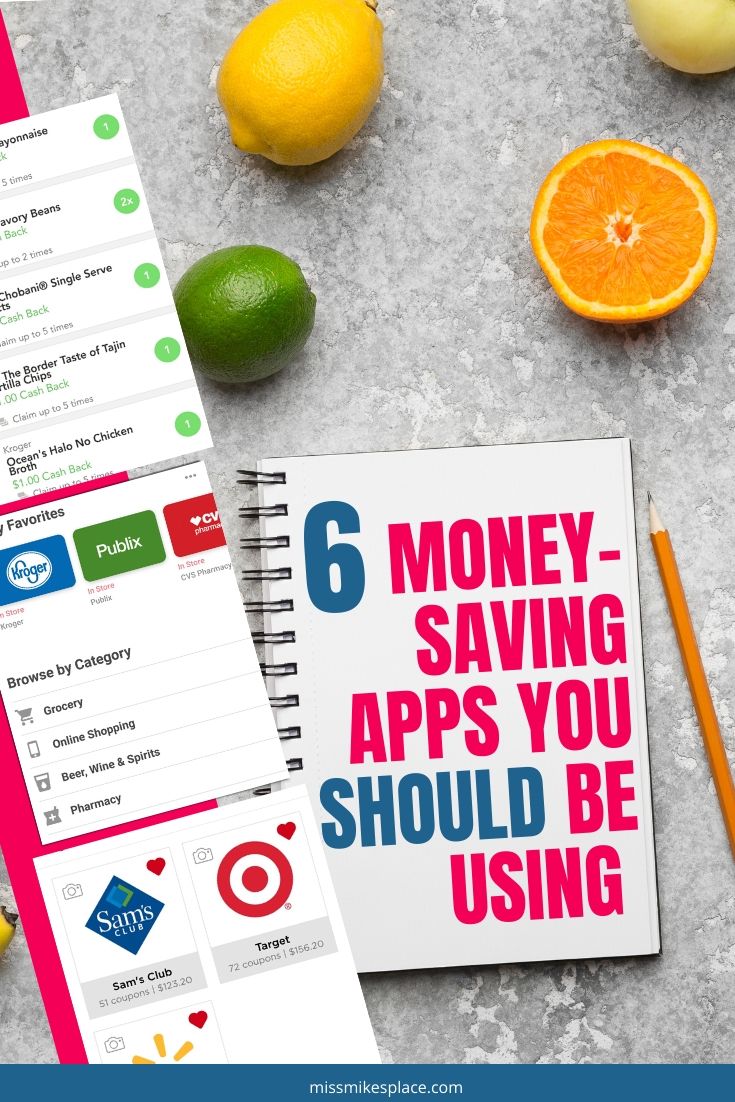6 Steps to Stop Living Paycheck to Paycheck
Follow these easy tips to break the paycheck-to-paycheck cycle
It doesn’t matter how much money you take home in your paycheck, it’s how you spend your money that makes the difference in your financial security.
Money is a tool that is necessary to navigate our world. It’s not about happiness, power, or self-worth. How you feel about money should not get in the way of using it properly just as you would any other tool in your life skills toolbox.
I saw a graphic recently that summed up the whole issue. It was a comparison of what most of us usually do and what wealthy people do. A quick example was a winter coat. The less money we have, the more we are willing to spend on the coat. I’m not the first to say it, and I don’t know who was but the gist of it is…
WEALTH IS QUIET – RICH IS LOUD – POOR IS FLASHY

This page contains affiliate links to products I use, love, and recommend. See my full disclosure policy.
Poor habits lead to this paycheck to paycheck cycle and people who make a lot of money are just as likely to live this way as people who make far less.
Spending right up to and beyond what you are earning. Making minimum payments. Living beyond your means.
Sound familiar.
I was guilty of this. I was guilty of spending more money than I could afford on an outfit I didn’t need. Eating out, or buying the next round at Happy Hour. Buying food that I ended up throwing out because I didn’t have a plan to cook it.
Then getting slammed with a repair bill that came out of left field and that I wasn’t at all prepared for. I got tired of reliving this particular nightmare.
I started looking for ways to get on firmer footing, I wanted to be in control of my finances so that I could solve the problems as they came up instead of just reacting to the hottest burning fire.
Looking for Answers
One of the answers I found was Dave Ramsey’s Debt Snowball Method which offers a simple strategy to wipe out debt. Another was a blog post written by Ken and Daria Dolan about the value of couponing and how much money you can save by smart couponing. No, I don’t have a lifetime supply of deodorant and mustard that I am hoarding in the spare bedroom.
I dove into both of these new strategies. My husband was totally on board and we haven’t looked back.
Here are some steps you can take to change the way you spend money.
You may not be ready to hop on the F.I.R.E. bandwagon, but you can break the paycheck-to-paycheck cycle.
1) Set up a Budget
It can be as simple as writing down on a sheet of notebook paper a list of what you have coming in and what you have going out. This is a helluva start if you’ve never gotten this far.
There are so many free options for budget spreadsheets. Excel and Google Docs both have free versions of perfectly serviceable budget spreadsheets.
Basic recommendations for budget percentages look like this:
50% – Things you need – think food, clothing, shelter. Cut out any excesses until you have a good handle on your finances. Living slightly below your means will free up the extra cash you need to fund your savings.
30% – Things you want – What this is for you is different from what it is for me. Cable, dining out, hair salons, new shoes, for example, will fall under this category. If you are in financial trouble, this is a good place to cut back until you are in control.
20% – Savings – Getting an emergency fund of $1000.00, including a short-term savings account equal to 3-6 months of expenses, and a long-term retirement fund is necessary for you to build the foundation of financial security.
Budget Apps to help you achieve your goals
Try a budget app like Mint.com which is free and available for Mac or PC, iOS, and Android. It has more than just budgeting capabilities, you decide if you need or want the bells and whistles. It syncs with your bank accounts and helps you track your spending in each category of your budget.
Another popular app is You Need A Budget.com or YNAB which offers a 30-day free trial and then costs about $5.00 per month. It is also available on Mac or PC, iOS and Android. This app is all about budgeting. It doesn’t offer more than that, but it is easier to use than Mint.com. You tell your money where to go, sync your bank account, monitor your spending activity. When you see that you are overspending in a specific category you can make adjustments by shifting funds from another category.
Deciding on a system that works for you and then STICKING WITH IT is how you succeed in breaking bad financial habits.
Budgets have to be adjusted as your needs or situation change, but staying in control of your money is within your power.
2) Start a Daily Spending Journal
Track your spending
It doesn’t have to be fancy, free would be best. A small notebook is all that is needed. Write down every time money is spent. Note any bills that are being paid, whether through automatic deduction or mailing a check, or paying in person.
List money spent daily on groceries, gas, meals, entertainment, school, or work activities. A contribution made towards a gift for an office co-worker. Coins tossed in a fountain. Every single expenditure needs to be written down.
Make smart money changes
If you don’t know where your money is going, you can’t make effective decisions.
After a month of keeping a meticulous spending journal, look at your entries. How many of those expenditures can be avoided by better day-to-day planning?
Food and entertainment costs are usually the easiest to rein in. Eating meals at home, packing lunches, having a movie night, or Happy Hour at home can have a tremendous positive impact on expenses.
Download my free Daily Spending tracker here. After a month of monitoring your spending habits, you begin to see where you might make changes…for the good!

3) Create an Emergency Fund and BEYOND
Emergency Fund
The first step to an emergency fund is to have an automatic deposit directly from your paycheck into a savings account. An emergency fund of $1000.00 will give you peace of mind and give you the resources to handle an emergency. If you have to dip into it, fine, but replenishing it becomes a priority.
Pay yourself first should be your new money-saving mantra. Pay yourself before you pay McDonald’s, or Starbucks, or Amazon.
Short Term Savings
When you have reached $1000.00 in your emergency fund in an account that is fairly easy to access (but not too easy) start sending money to a short-term account. Another automatic deduction from your paycheck to your savings account will make it simple for you. Shoot for 3-6 months of living expenses in a short-term savings account. This will tide you over in the event of a lay-off, job loss, or a short-term illness and help to avoid getting into debt because of unexpected emergencies.
Long Term Savings
The next level is long-term or retirement savings. Think you’re too young to do this? Think again. If your company offers to match your 401k contribution then jump on it. Otherwise, save as much as you can to contribute to an IRA each year. There is a limit to how much you can use as a deduction but it can reduce your taxable income so your tax liability is lowered as well.
4) Reduce Expenses
Look at every category in your budget, how much you are spending and see if there is a way to reduce it.
Housing
Are you paying too much for rent? Find a cheaper place.
Can you refinance your mortgage to lower your payments?
Can you take on a roommate for a limited time to help with expenses?
Insurances
Are your insurance costs through the roof? Put out a bid to at least 3 different insurance companies and see if you can save money on those costs.
Or sign up here for Gabi, load your current insurance information and let them sift through the rates from several top companies for comparable coverage; apples to apples.
I did this. While I haven’t changed insurance companies, I let my current company know what the difference was and you know what? They found ways to reduce my premiums by $720.00 per year with no change in coverage.
It’s an important exercise to do every year. It’s important to evaluate the coverage you have, what else you need, or what you no longer need, and what you are paying.
Food and Entertainment
Eating at home, coffee from home, entertainment at home. Until you have your savings accounts funded and a handle on paying off your debts you should consider keeping these costs as low as possible. It doesn’t hurt. It’s not like you have to do it forever. Although, once you get used to spending less you will not want to go back to wasting your hard-earned paycheck.
Plan meals for the week and avoid the high cost of eating out. Eat breakfast at home and pack lunches for the day.
You don’t know how to cook? Start with simple recipes, 5 ingredients or less, use a crockpot. Dinner is easy. Get in the kitchen and give it a go. This is an area of your budget where you can save a lot of money.
Plan around what’s on sale and what is seasonal.
Keep a pantry stocked with the basics you’ll need to prepare meals at home. Don’t forget the spices. You’ll be able to create copycat recipes from your favorite restaurants.
Check out my post for stocking a frugal pantry here and having a well-stocked spice cabinet here.
Couponing or at least using rebate apps can save you anywhere from 20%-50% on groceries. What’s stopping you? Sign up with your grocery store and drug store for their digital coupons. Programs like ibotta and Checkout51 are rebate apps that can save on groceries and household products.
When you reach a payout from any of these sources, re-allocate to the grocery budget OR send it to savings.
Shop with Ibotta in-store and online get up to $20 in Welcome Bonuses!
Have people over on Gameday or a Happy Hour at Home, or Movie Night. Share the cost of wings and beer, or whatever your snack of choice is.
Download Groupon and get discounts on restaurants, events, travel. You can have fun and STILL save money.
Do you have a library card? Well, get one. No more buying books on Amazon while you’re killing time waiting to see the dentist. Check out their movie selection. Most libraries offer DVDs and BluRays that you can borrow. For free!
Clothing
Thredup offers gently used clothing from brands that you know at greatly reduced prices. You can find things that still have tags on them.
Goodwill is another source of affordable clothing and household goods. You can find brand-new with tags designer brands at a fraction of the cost of regular retail or online stores. Imagine a shopping spree where you get a back-to-school wardrobe, a new coffee-maker, and a duvet cover and you get change back from a fifty! Check out your closest Goodwill store and see what it has to offer.
AND, supporting a Goodwill store is good for your community.
Devices
Check out MintMobile or Republic for lower monthly rates on your cell phone. By switching to MintMobile I reduced my cell phone bill by $540.00 per year with no difference in service.
If you have old phones or tablets lying around check out Gazelle. They will pay you for certain models. See if you have anything collecting dust that you can get cash for!
Saving money on the essentials is just the boost your paycheck needs.
5) Reduce Debt
Start the Snowball
Going through the Debt Snowball Method was an absolute game-changer in our household. Now, we had to first cut expenses to free up money for this to work. But I listed our debts in order from lowest to highest. We did not include the mortgage when listing our debts, to begin with. Credit card and car payments were our main concerns.
I focused on the smallest debt first. The minimum monthly payment for that debt was increased by the amount of money freed up by reducing our expenses. We made that payment until the balance was zero. Up to this point, minimum monthly payments were made to the remaining debts.
Keep it going
Once that first debt was paid, the additional funds went towards the next debt on my list. In four months this debt was paid in full.
We were now putting a substantial chunk of change towards the debt with the highest balance and it was paid off in full 6 months later.
The trick was to NOT use credit cards or buy anything that could not be paid in full within the month.
Now, the magic happened after about a year after we started the debt snowball method. All of the money going towards debt had another place to go. First the mortgage and then our long-term savings.
6) Increase Income
Extra Work
Getting a promotion or a pay raise may not be an option. Can you offer to put in some overtime or work an extra shift on a day off?
Do you have a particular skill or passion that you can tap into to earn additional money? This wouldn’t feel like work!
If you are a stay-at-home-Mom consider offering childcare services in your neighborhood. For detailed regulatory information in your state check out ChildCareAware.org
If you have a car payment consider spending 10 hours a week driving for Uber or Lyft to cover those monthly expenses.
If you have a weakness for a particular retailer see about getting a part-time job with the company. Earn an extra paycheck, if they offer an employee discount even better, and add to your savings.
Arrange a schedule where you won’t incur additional expenses such as childcare that would negate the income.
A side hustle that adds another paycheck may be a necessary short-term remedy that will pay off in the long term.
Clear out your clutter
Selling items on eBay or Craig’s List is a great way to get rid of excess stuff and create a source of revenue for your emergency fund.
Find a consignment shop in your area where you can resell clothes that are no longer worn. There is a market for that. Try ThredUp to resell gently used clothing.
Donate to your local Goodwill and take advantage of the tax deduction.
Building a stable financial foundation will not make you a better person than you already are, and I don’t believe you will be judged for all eternity for your lousy credit rating. But the peace of mind will extend to more areas of your life than you realize.
Follow my easy tips to put yourself in control of your money. You’ve got this!






